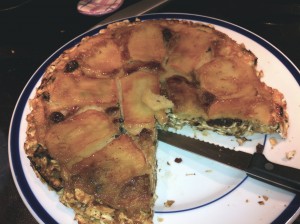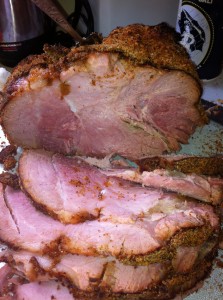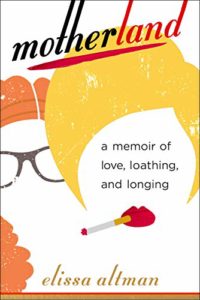It’s a universal truth:
At best, the act of cooking the foods of our forefathers and mothers is a delicious way to remain connected to our past, and to all that is good, right, and domestically romantic in our lives.
At worst, it can result in a closed mind, a misguided palate, and the sort of cloistered gastronomical specificity that keeps us from, on the one hand, speaking the truth about Grandma’s leaden matzo balls, and, on the other, looking reality square in the face and teaching our children to trust their tongues and not lie about what they know to be good or bad. It’s sort of the culinary version of The Emperor’s New Clothes.
It’s no surprise that I’m writing this just days after back-to-back springtime celebrations, the period of time when my Aunt Thelma’s matzo brei — a tasty if exceedingly dry, tarte tatin-like concoction is hauled out, over and over again, as my cousins and I attempt to create The Real Thing, just like my aunt makes it, in her ancient, peeling, formerly stick-proof pan. According to Aunt Thelma’s recipe, it calls for six boards of matzo, three eggs, and a few chopped apples, the latter of which get cooked in enough PAM to grease every engine at the Indy 500. Once it’s inverted onto a plate, it’s ultimately a beautiful bit of business, but it is, in fact, dry. My cousin Nina, Aunt Thelma’s youngest daughter, makes it her own way, using the same sort of stick-proof pan (also peeling, also a little worse for wear having spent many meals over very high heat), but with olive oil, which imparts more of a fried sensibility to it and cooks the eggy matzo a little bit faster.
What’s so special about this dish? Is it the fact that it is so mouthwateringly delicious that we lay awake at night and dream about it over the long, harsh winter, salivating in our sleep? No. It’s the fact that it is Aunt Thelma’s Matzo Brei, and that, while the big, harsh world spins around us, it provides some level of emotional safety as everything else is in a constant state of flux, and change. Even if the dish is just sort of okay.
It took my cousin Mishka, Thelma’s oldest granddaughter, to quietly take matters into her own hands and to say “Look, if we’re going to eat this thing, let’s make it really good.” The implication wasn’t that Aunt Thelma’s original version, or Nina’s spin on it weren’t good; they were. They’ve just gotten a little bit chore-ish, and obligatory-feeling, and therefore no one dares make the major changes to the dish that it has needed: the longer matzo soak, the much slower cook. Instead, everyone just tries to duplicate the original, which is nowhere nearly as delicious as it might be, or as we honestly think it is. But last week, just a few days after having her first child — and with a sea of noisy people (us) streaming in and out of her house — Mishka pulled Susan into her kitchen, took out a proper frittata pan (it latches together and looks sort of like a flattened cataplana), and said “Watch.” Mishka took her time and cooked thoughtfully and peacefully; there was the longer soak. There was cardamom involved and a handful of diced figs and dried cherries in addition to the apples. And the result was utterly, completely spectacular, if totally different.
A few days later, Susan and I drove up to cook Easter supper for Helen, her 93-year-old mother, and a few of her cousins; the menu, which we consulted on, would be the same as it always is — mashed potatoes, green bean casserole, glazed carrots, kielbasa, and ham. A week or so earlier, I called our local butcher, Steve Ford, and ordered a smallish, bone-in smoked ham, and the fresh kielbasa, the latter of which he made himself. Over the eleven years that I’ve been in the picture, making ham for Susan’s mother’s Easter dinner has become something of a proving ground; the image of a Jewish lesbian wearing Lily Pulitzer capris and a lime green sweater, and in the oven up to her shoulders with a pig ought to be enough, really, but it never is. One year, I glazed it with an orange juice/Bourbon/ginger ale concoction; another year, the glaze involved Coca Cola and English mustard. But the only time Helen’s ever been happy was when she went shopping before we could, and I walked into her house to find a sixteen pound Cooks’ ham sitting in the kitchen sink, floating in a vat of milk.
“It gets rid of some of the salt,” she said, chewing on her bottom lip. “But really, Cooks’ is the best. The best!” Two hours after we ate this beast, which had been roasted without benefit of glaze or foil, my ankles began to leach out over the sides of my shoes, and I couldn’t get my rings off.
I wanted to say “Look, this is inedible; you shouldn’t be eating this amount of salt, and the color of the meat doesn’t exist in nature, no matter how packed with nitrates it is.” But, I couldn’t. Because, like our ancient matzo brei recipe that always manages to be a little bit dry and that has the gastrointestinal staying power of cement, a plain Cooks’ ham that tastes like it’s been dragged through the Bonneville Salt Flats is what my mother-in-law thinks is good. And perception is a very personal thing.
The fact that I will never, ever learn to keep my mouth shut is a family trait, and so this year, I took my cousin Mishka’s approach, and I didn’t ask permission; instead, I made the Easter ham recipe from Canal House Cooking’s Volume #6: The Grocery Store. Simmered in apple cider for a few hours (the recipe called for four hours and a sixteen pound ham, but this was much smaller), patted down with a shellack of Dijon mustard melted together with brown sugar, and then coated with toasted breadcrumbs, it was — appropriate to the holiday — completely miraculous in its unctuousness. It hit every right note, managing to be sweet, tender, juicy, and wrapped in a glaze that was both gooey and crispy, all at once, and I’ll never make ham another way. Susan’s cousin Bobbie swooned, and her husband, Shawn, ate slice after slice, proclaiming it remarkable.
Susan’s mother wouldn’t go near it; she just stared.
We were on our way out, packing the car to come home and she took me aside to give me some advice:
“Where I come from,” Helen said, “a Cooks’ ham is good enough.”
And although it pained me to do it, I had to agree.






A thoroughly delightful read. Thank you, once again, for insight and the giggle.
Loved this, E.
Great post.
Canal House is wonderful. This ham does look amazing. But I sent you a little tip on how to make a Cook’s ham taste rip-the-meat-off-the-bone delicious.
OMG! The boring, unseasoned in any way, oyster stew we were forced to eat every Christmas Eve. No one liked it, no one wanted it year after year, but we were all too afraid to “mess with tradition”. And then out of the mouths of babes, my very youngest cousin rose up in revolt and the walls came tumbling down. Turns out, even Grandma who made each year didn’t like it!! So oyster stew was switched to a lovely creamy roasted corn chowder and all is calm, all is bright.
Love the mental images! In our family it was/is the bi-colored jell-o mold my grandmother made for Thanksgiving. Red and green, as I child I thought it was mildly revolting, as an adult I find it amusing and tolerable. I had hoped we were free of the lime flavor with celery and the red flavor (what flavor is red?) but suddenly my dad asked for it a few years back and the tradition has been revived. Fortunately, I don’t have to make the darn thing.
Elissa, you’ve sure got the gift! You are so right, family holiday cooking traditions are a trip. This year my daughter told me about a jello salad making an appearance on her Easter menu, in honor of her great grandmother who made such things. She described a recipe involving strawberry jello, pretzels, and (I shudder to think) chocolate. I hate to admit it, but I did let out a little scream and suggest that perhaps they had given me the wrong baby at the hospital. Long story short, she made a more delicate lime and pear jello salad with a horseradish mayo, a modern take on one of my grandmother’s favorites. A new take on an old favorite.
We are so honored that you chose to make the Canal House ham. Next time invite us please, we’d love to get in the kitchen with you, Susan and Helen.
I love this piece! It made me laugh.
Last night we ate what I term a ‘proper dinner’: ham, mashed potato, piccalilli, peas and carrots slathered in cheesy white sauce. A reminder of how simple food is all one needs. At Christmas time my mum always makes roast ham with English mustard and demerara sugar, studded with cloves courtesy of Delia Smith – I’ve not come across better.
The best part? Leftovers! Breakfast of bubble and squeak potato cakes, ham and poached eggs.
Thanks so much Christopher. Strawberry jello, pretzels, and chocolate? Baby switched at birth. As for next time, you both are coming for the holiday. And there will be nary a Cooks’ ham in sight.
I won’t say (in a public forum anyway) which family recipes I have to doctor all to hell to make them good, so I’ll simply say, I hear you!
One rarely finds insight and gentle humor in the same read. I really enjoyed your post today. I’m new to your blog and have spent some time exploring and browsing through your earlier post. I’m so glad I did. You’ve created a soft spot for readers to land and I really enjoyed the time I spent here. I’ll be back. I hope you have a great day. Blessings…Mary
What a kind and lovely note. Thanks so much Mary. Glad you found the blog and are enjoying it.
Isn’t this the balance, truly, for us foodies? I mean, I’ll bet most of us came from incinerating or blechifying or nonsense-food traditions. (My mother still can make pork chops sizzle angrily. I don’t know how she does it.) I want to step in, I do, I don’t, I wish I had, I wish I hadn’t, ever a dance. But I’d eat that darn ham any day of the week, no matter what anyone says.